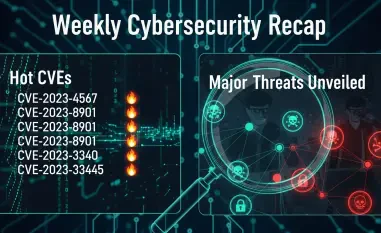The rapid advancement of artificial intelligence (AI) and machine learning (ML) has revolutionized various industries, including cybersecurity. While these technologies have significantly bolstered defenses, they have also provided cybercriminals with powerful tools to enhance their attack strategies. The integration of AI and ML into both defensive and offensive cyber measures presents a double-edged sword; while these innovations enable quicker threat identification and mitigation, they also empower attackers to execute more complex, larger-scale, and effective cyberattacks. This article delves into the myriad ways hackers are exploiting AI and ML, highlighting the evolving threat landscape and the urgent need for robust defensive strategies.
Spam and Phishing Optimization
For years, spam detection has been a prime application of machine learning in cybersecurity. By understanding and reverse-engineering the algorithms of spam filters, attackers can cleverly refine their spam messages to bypass these defenses. This sophisticated approach involves attackers repeatedly testing their messages against spam filters, receiving feedback, and adjusting their content to create increasingly intricate spam campaigns. This feedback loop ensures that over time, spam messages become more adept at evading detection systems, posing a persistent challenge to cybersecurity professionals.
In tandem, AI is used to create more convincing and personalized phishing emails. Generative AI analyzes vast datasets to craft messages tailored to specific demographics or individual targets. This level of personalization extends to embedding realistic images, creating personas, and even fabricating social media profiles to bolster the legitimacy of phishing attempts. Studies have underscored a significant uptick in email-based phishing attacks driven by AI, making them more successful and harder to identify. By enhancing the authenticity of phishing emails, attackers increase the likelihood of tricking recipients into divulging sensitive information or clicking on malicious links.
Smarter Password Cracking
Machine learning greatly enhances password guessing techniques by analyzing patterns and trends in commonly used passwords, allowing algorithms to predict and guess passwords with heightened accuracy and fewer attempts. The capability becomes particularly dangerous when attackers combine it with data from previous breaches, thereby constructing powerful password-cracking dictionaries. This sophisticated approach can swiftly compromise accounts, especially those secured by weak or commonly used passwords.
The use of AI in password cracking not only diminishes the time and effort traditionally required to breach accounts, but also automates the process, making it more efficient and effective. The threat is further amplified when considering that AI can sift through enormous datasets to spot correlations and patterns human attackers might miss. As a result, the proliferation of AI-enhanced password-cracking tools poses a severe danger to both individuals and organizations, highlighting the critical need for robust password policies and multi-factor authentication mechanisms.
Deep Fakes: Audio and Video Deception
The development of deep fake technology has introduced innovative ways for attackers to deceive their targets. By generating hyper-realistic audio and video, cybercriminals can convincingly impersonate trusted individuals, thereby manipulating others into revealing sensitive information or authorizing fraudulent transactions. High-profile incidents have already demonstrated the significant financial ramifications of such deep fake scams, underscoring the urgency of addressing this evolving threat.
Beyond financial gain, deep fakes are leveraged to spread misinformation and create social unrest. The ability to fabricate convincing fake content has ramifications that extend well beyond individual scams, with the potential to affect public perception and trust on a broader scale. This power makes deep fakes an exceptionally potent tool in the hands of cybercriminals and highlights the pressing need for advanced detection and verification technologies to combat this form of deception.
Neutralizing Security Tools
Many contemporary security tools incorporate AI to identify suspicious activities and behaviors. However, attackers can use these same tools to test and refine their malware, ensuring that it evades detection by AI-based defenses. By analyzing how these security tools function, attackers can modify their attack patterns to exploit weaknesses and blind spots in AI models. For instance, tools like AI-powered grammar checkers help attackers craft phishing emails devoid of glaring linguistic errors, making their scams more credible.
This cat-and-mouse game between attackers and defenders emphasizes the necessity of continual advancement in cybersecurity measures. As attackers become more adept at bypassing security tools, organizations must invest in evolving their defensive strategies and incorporating more sophisticated AI-driven solutions that can anticipate and counteract innovative attack methods.
Automated Reconnaissance
AI and ML significantly enhance the data-gathering phase of an attack by automating reconnaissance efforts. Attackers can leverage these technologies to scan publicly available information, traffic patterns, and system defenses to identify vulnerabilities with remarkable precision. The automation of this reconnaissance phase not only accelerates the process but also improves the accuracy and thoroughness of the gathered intelligence, giving cybercriminals a considerable edge in planning and executing their attacks.
With automated reconnaissance, attackers can amass vast amounts of data swiftly, enabling them to pinpoint potential targets and weaknesses more efficiently. This methodical approach grants cybercriminals a strategic advantage, allowing for meticulously designed attacks that exploit identified vulnerabilities with pinpoint accuracy. The broad implications of this efficiency highlight the critical need for organizations to maintain rigorous security measures and regularly audit their digital footprint to mitigate risks effectively.
Autonomous Agents: Persistent Attacks
The advent of AI-powered autonomous malware agents marks a significant evolution in cyberattack methodologies. These agents can operate independently without relying on constant command-and-control communication, adjusting their behavior based on the environment to ensure long-term persistence within a compromised network. This autonomy reduces the attackers’ need for direct intervention, making it exponentially harder for defenders to detect and eradicate the persistent threat.
Autonomous agents represent a game-changer in malware technology, as they adapt to shifting conditions and continuously evade defensive measures. Their resilient nature and ability to alter tactics in response to defensive actions render them particularly challenging to counteract, necessitating more sophisticated and proactive cybersecurity strategies to detect and neutralize these threats effectively.
AI Poisoning: Manipulating Training Data
Data poisoning is another technique leveraged by attackers to compromise machine learning models. By injecting malicious data into training datasets, attackers can introduce biases or misleading information, thereby skewing the model’s outputs. This manipulation can lead to the model misclassifying threats or overlooking particular attack patterns, significantly undermining its efficacy. For example, attackers could alter a model to perceive malicious activity as benign, resulting in missed detections that could have severe security implications.
Ensuring the integrity of training data becomes crucial in maintaining AI-based security measures’ effectiveness. Organizations must implement robust vetting and validation processes to safeguard against data poisoning, thereby preserving the reliability and accuracy of their AI-driven defenses.
AI Fuzzing: Finding Vulnerabilities
Fuzzing is a technique used to uncover software vulnerabilities by feeding it random inputs. AI-powered fuzzing enhances this process by making it more efficient and targeted. These AI tools can generate inputs that are more likely to expose exploitable weaknesses in software, accelerating the discovery of zero-day exploits, which attackers can use to compromise systems before patching efforts are initiated. This proactive approach enables attackers to identify and exploit vulnerabilities with greater speed and precision.
The adoption of AI in fuzzing has transformed vulnerability discovery, turning it into a more streamlined and effective process. As a result, cybersecurity professionals must stay abreast of these advancements and continuously update their defense mechanisms to promptly address and remediate identified vulnerabilities.
Autonomously Evolving Malware
Generative AI is being used to develop malware that continuously adapts and evolves to evade detection mechanisms. By periodically altering its code, AI-generated malware can avoid signature-based defenses, making it more resilient against traditional detection methods. This continuous evolution renders the malware harder to counteract, as it morphs to adapt to the defensive strategies employed against it.
The resilience of AI-generated malware underscores the urgent need for innovative and adaptive cybersecurity measures. Traditional signature-based approaches become obsolete in the face of such evolving threats, necessitating a shift towards more dynamic and intelligent defensive strategies that can respond to and counteract the ever-changing nature of AI-driven malware.
Lowering the Expertise Barrier
AI advancements have democratized the capabilities required to launch sophisticated cyberattacks, making high-level attack tools accessible to a broader range of potential cybercriminals. Previously, executing advanced attacks required significant expertise and resources. Now, commercial platforms and open-source libraries have lowered the entry barrier, enabling less-skilled attackers to deploy complex attacks easily. This growing accessibility broadens the pool of potential attackers and increases the frequency and complexity of cyber incidents.
The democratization of cyber threat capabilities poses a significant challenge, as it widens the threat landscape and makes sophisticated attacks more commonplace. Organizations must recognize this evolving threat and invest in comprehensive cybersecurity strategies that go beyond traditional defenses, incorporating proactive measures and continuous monitoring to protect against a wider array of potential attackers.
Common Themes and Overarching Trends
The consensus among cybersecurity experts is clear: AI and ML are double-edged swords in the realm of cybersecurity. While they offer invaluable tools for defending against threats, they also empower attackers with means to execute more nuanced and effective attacks. The increasing prevalence of AI-enabled cyberattacks has prompted many organizations to recognize the urgent need to improve their defensive strategies to counteract these threats.
Several key trends have emerged from the aggregated findings of various studies and expert analyses. A notable trend is the substantial increase in investments in AI security, reflecting the growing concern over the rise of AI-powered cyber threats. Furthermore, the dual role of AI in cybersecurity, aiding both attack and defense, poses a critical challenge. While AI assists in identifying and mitigating threats, it concurrently lowers the barrier for attackers to perform complex attacks with minimal effort.
The Nuances and Diverse Perspectives
The perspectives highlighted in this article cover various aspects of the use of AI in cyberattacks. Experts emphasize that AI tools explicitly designed for malicious activities, such as FraudGPT and WormGPT, exemplify the advanced threat landscape. Additionally, AI’s ability to facilitate impersonation through deep fakes introduces new avenues for social engineering attacks with potentially drastic consequences for businesses.
AI and ML’s application in reconnaissance enables more precise attacks by automating the data collection and analysis processes, underscoring the need for organizations to be vigilant about the information they inadvertently disclose through public channels. Moreover, AI’s role in autonomous agents and AI poisoning highlights the sophisticated threat actors capable of utilizing these technologies, presenting unique challenges for cybersecurity defenses.
Main Findings and Conclusion
The rapid progression of artificial intelligence (AI) and machine learning (ML) has created significant transformations across various sectors, especially in cybersecurity. Although these technologies have markedly improved defensive measures, they have equally equipped cybercriminals with advanced tools to enhance their attack techniques. Integrating AI and ML into both defensive and offensive cyber operations resembles a double-edged sword; these innovations allow for quicker threat detection and response, yet they also enable attackers to orchestrate more sophisticated, wide-ranging, and effective cyberattacks.
Hackers are increasingly leveraging AI and ML to automate their attacks, making them faster and harder to trace. Techniques such as spear-phishing, malware development, and social engineering have become more efficient and damaging due to AI’s optimization capabilities. For instance, cybercriminals utilize ML algorithms to identify vulnerabilities in systems, predict security lapse patterns, and even mimic human behavior to bypass traditional security measures effortlessly.
This evolving threat landscape underscores the necessity for robust defensive strategies. Security experts must stay ahead by continuously enhancing AI-driven defenses, implementing more rigorous monitoring systems, and engaging in proactive threat intelligence. By understanding how hackers exploit AI and ML, organizations can better fortify their defenses and mitigate potential risks in this high-stakes cyber battleground.













